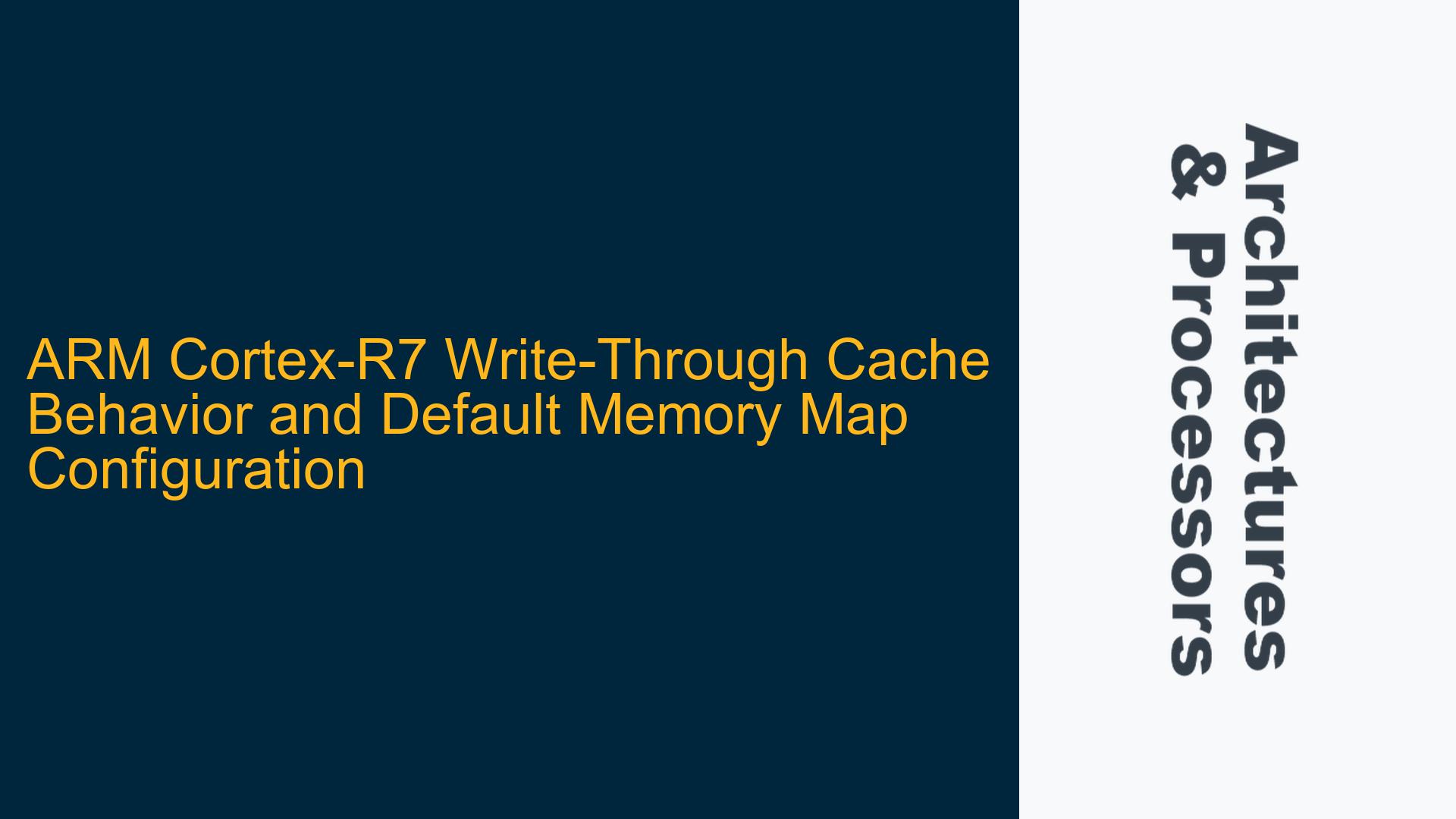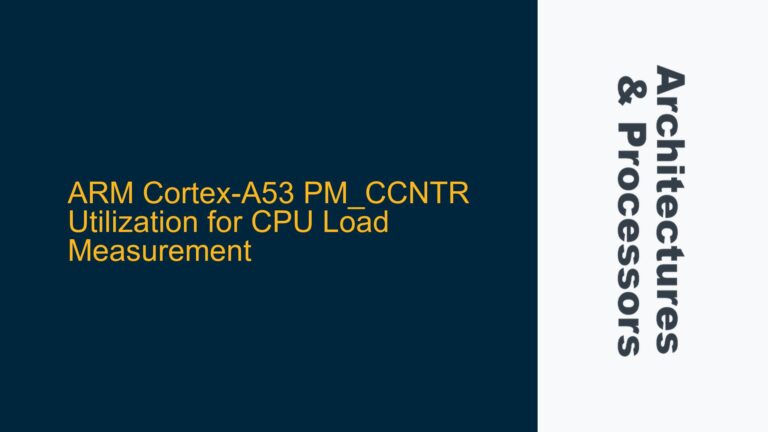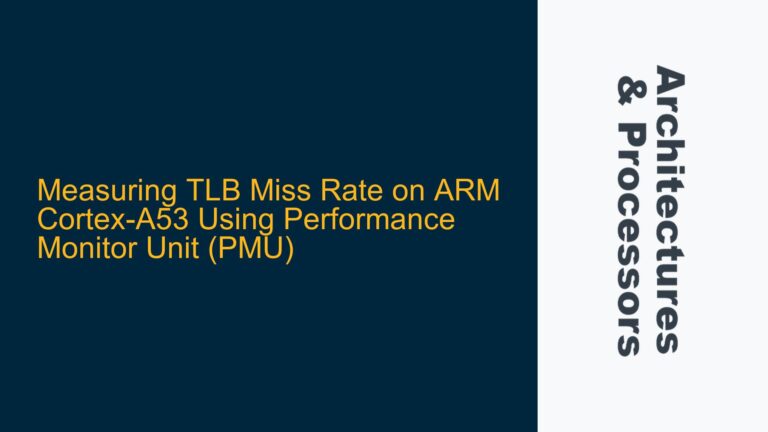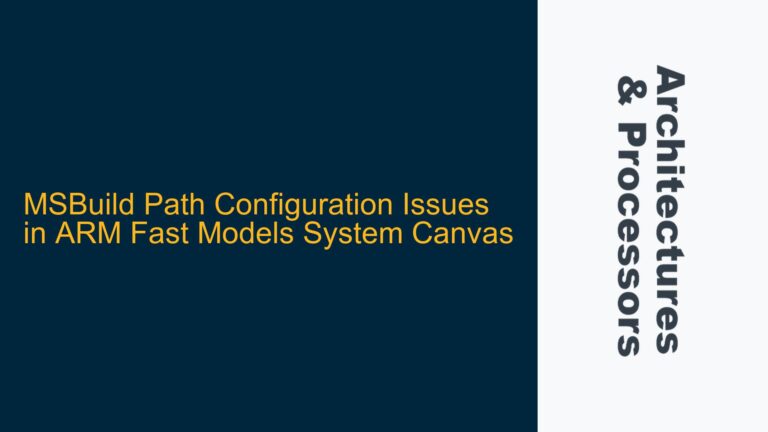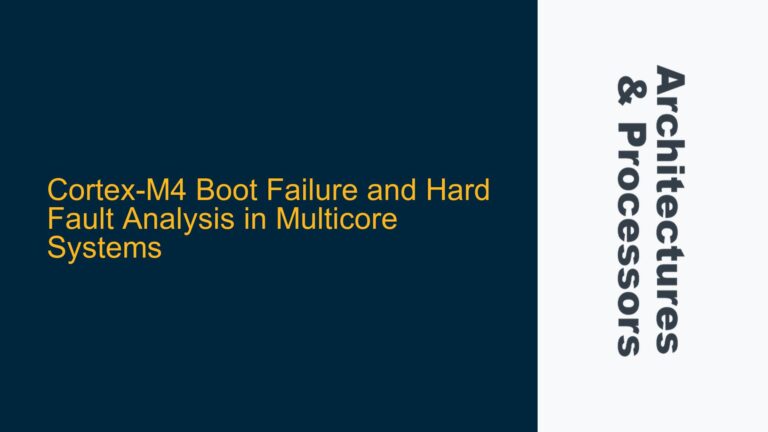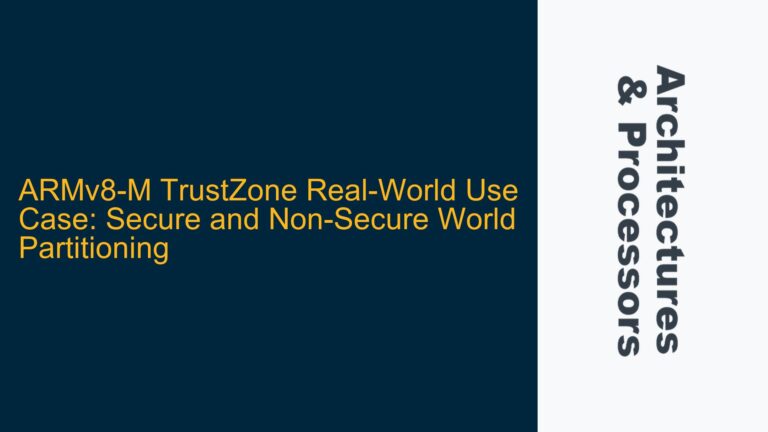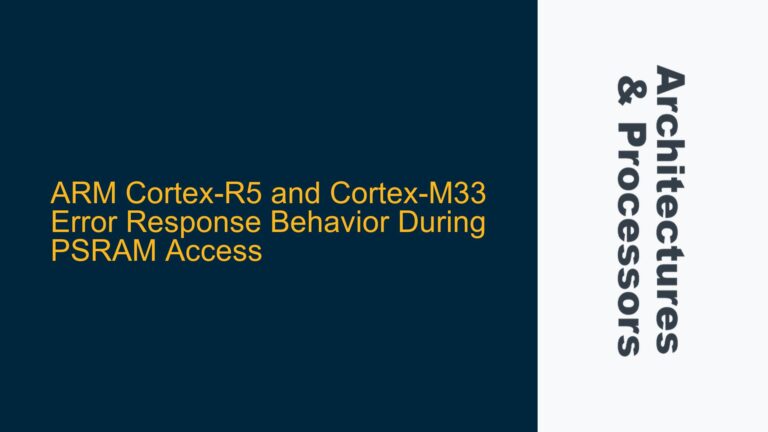ARM Cortex-R7 Write-Through Cache Behavior in Default Memory Map
The ARM Cortex-R7 processor, a member of the ARMv7-R architecture family, is widely used in real-time and safety-critical applications due to its deterministic performance and high reliability. However, one of its architectural nuances is the lack of support for Write-Through (WT) caching. This limitation can lead to unexpected behavior when the default memory map of ARMv7 is applied, particularly in regions marked as "Write-Through Cacheable." Understanding how the Cortex-R7 handles these regions is critical for ensuring correct system behavior, especially when the Memory Protection Unit (MPU) is disabled or misconfigured.
In the default ARMv7 memory map, certain memory regions are designated as "Write-Through Cacheable" when cache is enabled. This configuration assumes that the processor supports WT caching, which ensures that data written to the cache is simultaneously written to main memory. However, since the Cortex-R7 does not support WT caching, it treats these regions as Normal Non-Cacheable (NC). This behavior can lead to performance degradation, data inconsistency, or even system failures if not properly accounted for in the system design.
The core issue revolves around the mismatch between the default memory map expectations and the Cortex-R7’s actual capabilities. When the MPU is disabled, the system relies on the default memory map, which assumes WT caching support. This can result in unintended memory access patterns, particularly in systems where cache coherency and deterministic memory access are critical.
Cortex-R7 Cache Attribute Handling and Default Memory Map Implications
The Cortex-R7’s handling of cache attributes is governed by its architectural design, which prioritizes simplicity and determinism over flexibility in caching strategies. Unlike other ARM cores, such as the Cortex-A series, the Cortex-R7 does not implement Write-Through caching. Instead, it supports Write-Back (WB) caching and Non-Cacheable (NC) memory attributes. When a memory region is marked as Write-Through Cacheable in the default memory map, the Cortex-R7 interprets this as a suggestion rather than a strict requirement. Since it cannot fulfill the WT caching requirement, it defaults to treating the region as Normal Non-Cacheable.
This behavior has several implications for system design and performance:
-
Performance Impact: Treating WT regions as NC can lead to increased memory access latency, as every read and write operation must access main memory directly. This can be particularly problematic in real-time systems where deterministic access times are critical.
-
Data Consistency: In systems where multiple masters (e.g., DMA controllers) access the same memory regions, the lack of WT caching can lead to data inconsistency. Without WT caching, there is no guarantee that writes from the Cortex-R7 are immediately visible to other masters.
-
Power Consumption: Non-cacheable memory accesses consume more power compared to cacheable accesses, as they involve more frequent main memory transactions. This can be a concern in power-sensitive applications.
-
Software Assumptions: Software written for ARMv7 processors that assume WT caching support may behave incorrectly on the Cortex-R7. This is especially true for legacy code or code ported from other ARM cores.
To mitigate these issues, it is essential to understand the Cortex-R7’s cache attribute handling and adjust the system design accordingly. This includes configuring the MPU to explicitly define memory regions as Write-Back Cacheable or Non-Cacheable, depending on the application requirements.
Configuring Cortex-R7 Memory Attributes for Optimal Performance and Consistency
To address the Cortex-R7’s lack of Write-Through caching support and ensure optimal system performance, the following steps should be taken:
-
MPU Configuration: The Memory Protection Unit (MPU) should be configured to explicitly define memory regions with appropriate cache attributes. For regions that would typically be marked as Write-Through Cacheable, consider using Write-Back Cacheable or Non-Cacheable attributes instead. This ensures that the Cortex-R7’s behavior aligns with the system’s requirements.
-
Cache Coherency Management: In systems with multiple masters, such as DMA controllers, ensure that cache coherency is maintained. This may involve using cache maintenance operations, such as cleaning or invalidating cache lines, to ensure that data written by the Cortex-R7 is visible to other masters.
-
Performance Optimization: To mitigate the performance impact of treating WT regions as NC, consider reorganizing memory accesses to minimize latency. This may involve using Write-Back Cacheable regions for frequently accessed data and Non-Cacheable regions for infrequently accessed or shared data.
-
Software Adjustments: Review and modify software to account for the Cortex-R7’s caching limitations. This may involve replacing assumptions about WT caching with explicit cache management operations or adjusting memory access patterns to align with the Cortex-R7’s capabilities.
-
Power Management: To reduce power consumption, minimize the use of Non-Cacheable memory regions where possible. Use Write-Back Cacheable regions for data that can benefit from caching, and ensure that cache maintenance operations are performed efficiently.
By following these steps, developers can ensure that their systems leverage the Cortex-R7’s strengths while mitigating the limitations imposed by its lack of Write-Through caching support. Proper configuration and management of memory attributes are key to achieving reliable and efficient system performance.
Detailed Explanation of Cortex-R7 Cache Attribute Handling
The Cortex-R7’s cache attribute handling is a critical aspect of its architecture that directly impacts system performance and behavior. Unlike other ARM cores, the Cortex-R7 does not support Write-Through caching, which means it cannot simultaneously write data to both the cache and main memory. Instead, it supports Write-Back caching, where data is written only to the cache and later written back to main memory when the cache line is evicted.
When the Cortex-R7 encounters a memory region marked as Write-Through Cacheable in the default memory map, it cannot fulfill this requirement due to its architectural limitations. As a result, it defaults to treating the region as Normal Non-Cacheable. This behavior is consistent with the ARM architecture’s principle of allowing processors to implement more conservative caching strategies than those specified in the memory map.
The implications of this behavior are significant, particularly in systems where cache coherency and deterministic memory access are critical. For example, in a system with a DMA controller accessing the same memory region as the Cortex-R7, the lack of WT caching can lead to data inconsistency. Without WT caching, there is no guarantee that writes from the Cortex-R7 are immediately visible to the DMA controller, potentially leading to incorrect data being processed.
To address these issues, developers must carefully configure the MPU to define memory regions with appropriate cache attributes. For regions that would typically be marked as Write-Through Cacheable, consider using Write-Back Cacheable or Non-Cacheable attributes instead. This ensures that the Cortex-R7’s behavior aligns with the system’s requirements and avoids unintended side effects.
Practical Example: MPU Configuration for Cortex-R7
To illustrate the practical steps involved in configuring the MPU for the Cortex-R7, consider the following example. Suppose a system has three memory regions:
- Code Region: Frequently accessed by the Cortex-R7 for instruction fetches.
- Data Region: Frequently accessed by the Cortex-R7 for data reads and writes.
- Shared Region: Accessed by both the Cortex-R7 and a DMA controller.
The default memory map might mark these regions as Write-Through Cacheable, but since the Cortex-R7 does not support WT caching, the MPU must be configured to define these regions with appropriate cache attributes. The following table summarizes the recommended MPU configuration:
| Memory Region | Default Attribute | Recommended Attribute | Rationale |
|---|---|---|---|
| Code Region | Write-Through Cacheable | Write-Back Cacheable | Improves performance by caching frequently accessed instructions. |
| Data Region | Write-Through Cacheable | Write-Back Cacheable | Improves performance by caching frequently accessed data. |
| Shared Region | Write-Through Cacheable | Non-Cacheable | Ensures data consistency between Cortex-R7 and DMA controller. |
By configuring the MPU in this way, the system can achieve optimal performance and data consistency while accounting for the Cortex-R7’s lack of Write-Through caching support.
Conclusion
The ARM Cortex-R7’s lack of Write-Through caching support presents unique challenges for system designers, particularly when using the default ARMv7 memory map. By understanding the Cortex-R7’s cache attribute handling and configuring the MPU appropriately, developers can ensure that their systems achieve reliable and efficient performance. Proper management of memory attributes, cache coherency, and software assumptions is key to leveraging the Cortex-R7’s strengths while mitigating its limitations. With careful design and configuration, the Cortex-R7 can be a powerful and dependable choice for real-time and safety-critical applications.
